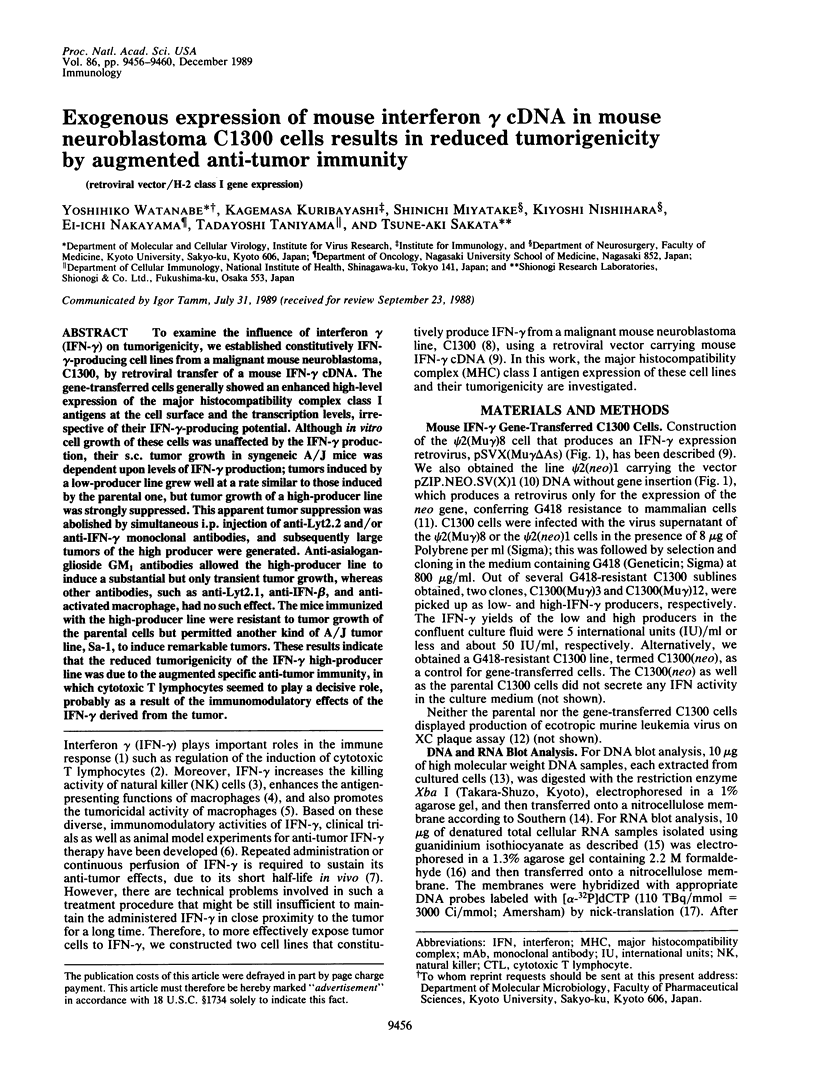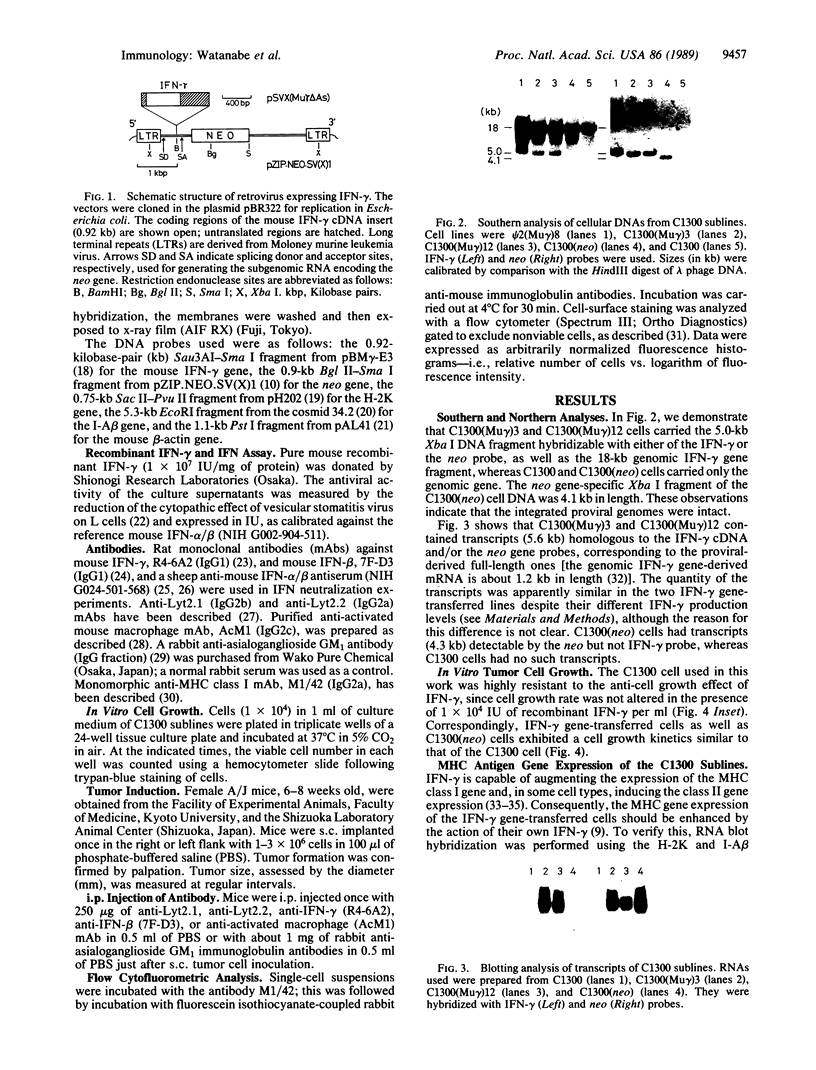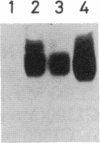Abstract
To examine the influence of interferon gamma (IFN-gamma) on tumorigenicity, we established constitutively IFN-gamma-producing cell lines from a malignant mouse neuroblastoma, C1300, by retroviral transfer of a mouse IFN-gamma cDNA. The gene-transferred cells generally showed an enhanced high-level expression of the major histocompatibility complex class I antigens at the cell surface and the transcription levels, irrespective of their IFN-gamma-producing potential. Although in vitro cell growth of these cells was unaffected by the IFN-gamma production, their s.c. tumor growth in syngeneic A/J mice was dependent upon levels of IFN-gamma production; tumors induced by a low-producer line grew well at a rate similar to those induced by the parental one, but tumor growth of a high-producer line was strongly suppressed. This apparent tumor suppression was abolished by simultaneous i.p. injection of anti-Lyt2.2 and/or anti-IFN-gamma monoclonal antibodies, and subsequently large tumors of the high producer were generated. Anti-asialoganglioside GM1 antibodies allowed the high-producer line to induce a substantial but only transient tumor growth, whereas other antibodies, such as anti-Lyt2.1, anti-IFN-beta, and anti-activated macrophage, had no such effect. The mice immunized with the high-producer line were resistant to tumor growth of the parental cells but permitted another kind of A/J tumor line, Sa-1, to induce remarkable tumors. These results indicate that the reduced tumorigenicity of the IFN-gamma high-producer line was due to the augmented specific anti-tumor immunity, in which cytotoxic T lymphocytes seemed to play a decisive role, probably as a result of the immunomodulatory effects of the IFN-gamma derived from the tumor.
Full text
PDF




Images in this article
Selected References
These references are in PubMed. This may not be the complete list of references from this article.
- Adams D. O., Hamilton T. A. The cell biology of macrophage activation. Annu Rev Immunol. 1984;2:283–318. doi: 10.1146/annurev.iy.02.040184.001435. [DOI] [PubMed] [Google Scholar]
- Birmingham J. R., Chesnut R. W., Kappler J. W., Marrack P., Kubo R., Grey H. M. Antigen presentation to T cell hybridomas by a macrophage cell line: an inducible function. J Immunol. 1982 Mar;128(3):1491–1492. [PubMed] [Google Scholar]
- Cantell K., Fiers W., Hirvonen S., Pyhälä L. Circulating interferon in rabbits after simultaneous intramuscular administration of human alpha and gamma interferons. J Interferon Res. 1984 Spring;4(2):291–293. doi: 10.1089/jir.1984.4.291. [DOI] [PubMed] [Google Scholar]
- Carrel S., Schmidt-Kessen A., Giuffrè L. Recombinant interferon-gamma can induce the expression of HLA-DR and -DC on DR-negative melanoma cells and enhance the expression of HLA-ABC and tumor-associated antigens. Eur J Immunol. 1985 Feb;15(2):118–123. doi: 10.1002/eji.1830150204. [DOI] [PubMed] [Google Scholar]
- Cepko C. L., Roberts B. E., Mulligan R. C. Construction and applications of a highly transmissible murine retrovirus shuttle vector. Cell. 1984 Jul;37(3):1053–1062. doi: 10.1016/0092-8674(84)90440-9. [DOI] [PubMed] [Google Scholar]
- Chirgwin J. M., Przybyla A. E., MacDonald R. J., Rutter W. J. Isolation of biologically active ribonucleic acid from sources enriched in ribonuclease. Biochemistry. 1979 Nov 27;18(24):5294–5299. doi: 10.1021/bi00591a005. [DOI] [PubMed] [Google Scholar]
- Colbère-Garapin F., Horodniceanu F., Kourilsky P., Garapin A. C. A new dominant hybrid selective marker for higher eukaryotic cells. J Mol Biol. 1981 Jul 25;150(1):1–14. doi: 10.1016/0022-2836(81)90321-1. [DOI] [PubMed] [Google Scholar]
- DUNHAM L. J., STEWART H. L. A survey of transplantable and transmissible animal tumors. J Natl Cancer Inst. 1953 Apr;13(5):1299–1377. [PubMed] [Google Scholar]
- De Maeyer-Guignard J., De Maeyer E. Immunomodulation by interferons: recent developments. Interferon. 1985;6:69–91. [PubMed] [Google Scholar]
- Farrar W. L., Johnson H. M., Farrar J. J. Regulation of the production of immune interferon and cytotoxic T lymphocytes by interleukin 2. J Immunol. 1981 Mar;126(3):1120–1125. [PubMed] [Google Scholar]
- Giacomini P., Imberti L., Aguzzi A., Fisher P. B., Trinchieri G., Ferrone S. Immunochemical analysis of the modulation of human melanoma-associated antigens by DNA recombinant immune interferon. J Immunol. 1985 Oct;135(4):2887–2894. [PubMed] [Google Scholar]
- Goodenow R. S., Vogel J. M., Linsk R. L. Histocompatibility antigens on murine tumors. Science. 1985 Nov 15;230(4727):777–783. doi: 10.1126/science.2997918. [DOI] [PubMed] [Google Scholar]
- Gray P. W., Goeddel D. V. Cloning and expression of murine immune interferon cDNA. Proc Natl Acad Sci U S A. 1983 Oct;80(19):5842–5846. doi: 10.1073/pnas.80.19.5842. [DOI] [PMC free article] [PubMed] [Google Scholar]
- Gross-Bellard M., Oudet P., Chambon P. Isolation of high-molecular-weight DNA from mammalian cells. Eur J Biochem. 1973 Jul 2;36(1):32–38. doi: 10.1111/j.1432-1033.1973.tb02881.x. [DOI] [PubMed] [Google Scholar]
- Grönberg A., Kiessling R., Masucci G., Guevara L. A., Eriksson E., Klein G. Gamma-interferon (IFN-gamma) produced during effector and target interactions renders target cells less susceptible to NK-cell-mediated lysis. Int J Cancer. 1983 Nov 15;32(5):609–616. doi: 10.1002/ijc.2910320515. [DOI] [PubMed] [Google Scholar]
- Hayashi H., Tanaka K., Jay F., Khoury G., Jay G. Modulation of the tumorigenicity of human adenovirus-12-transformed cells by interferon. Cell. 1985 Nov;43(1):263–267. doi: 10.1016/0092-8674(85)90031-5. [DOI] [PubMed] [Google Scholar]
- Herberman R. B., Ortaldo J. R. Natural killer cells: their roles in defenses against disease. Science. 1981 Oct 2;214(4516):24–30. doi: 10.1126/science.7025208. [DOI] [PubMed] [Google Scholar]
- Heremans H., Dijkmans R., Sobis H., Vandekerckhove F., Billiau A. Regulation by interferons of the local inflammatory response to bacterial lipopolysaccharide. J Immunol. 1987 Jun 15;138(12):4175–4179. [PubMed] [Google Scholar]
- Kawade Y., Watanabe Y., Yamamoto Y., Fujisawa J., Dalton B. J., Paucker K. Antigenic cross-reaction between the alpha types of human and mouse interferon. Antiviral Res. 1981 Sep;1(3):167–178. doi: 10.1016/0166-3542(81)90005-x. [DOI] [PubMed] [Google Scholar]
- Kawase I., Urdal D. L., Brooks C. G., Henney C. S. Selective depletion of NK cell activity in vivo and its effect on the growth of NK-sensitive and NK-resistant tumor cell variants. Int J Cancer. 1982 May 15;29(5):567–574. doi: 10.1002/ijc.2910290513. [DOI] [PubMed] [Google Scholar]
- Kuribayashi K., Masuda T., Hanaoka M. Lethal graft-versus-host disease in nude mice. I. Establishment of model systems. Transplantation. 1988 Aug;46(2):267–273. doi: 10.1097/00007890-198808000-00016. [DOI] [PubMed] [Google Scholar]
- Lehrach H., Diamond D., Wozney J. M., Boedtker H. RNA molecular weight determinations by gel electrophoresis under denaturing conditions, a critical reexamination. Biochemistry. 1977 Oct 18;16(21):4743–4751. doi: 10.1021/bi00640a033. [DOI] [PubMed] [Google Scholar]
- Minty A. J., Alonso S., Guénet J. L., Buckingham M. E. Number and organization of actin-related sequences in the mouse genome. J Mol Biol. 1983 Jun 15;167(1):77–101. doi: 10.1016/s0022-2836(83)80035-7. [DOI] [PubMed] [Google Scholar]
- Männel D. N., Falk W. Interferon-gamma is required in activation of macrophages for tumor cytotoxicity. Cell Immunol. 1983 Jul 15;79(2):396–402. doi: 10.1016/0008-8749(83)90082-5. [DOI] [PubMed] [Google Scholar]
- Nakayama E., Uenaka A. Effect of in vivo administration of Lyt antibodies. Lyt phenotype of T cells in lymphoid tissues and blocking of tumor rejection. J Exp Med. 1985 Feb 1;161(2):345–355. doi: 10.1084/jem.161.2.345. [DOI] [PMC free article] [PubMed] [Google Scholar]
- Nathan C. F., Kaplan G., Levis W. R., Nusrat A., Witmer M. D., Sherwin S. A., Job C. K., Horowitz C. R., Steinman R. M., Cohn Z. A. Local and systemic effects of intradermal recombinant interferon-gamma in patients with lepromatous leprosy. N Engl J Med. 1986 Jul 3;315(1):6–15. doi: 10.1056/NEJM198607033150102. [DOI] [PubMed] [Google Scholar]
- Nishihara K., Miyatake S., Sakata T., Yamashita J., Kikuchi H., Kawade Y., Zu Y., Namba Y., Hanaoka M., Watanabe Y. Augmentation of tumor targeting in a line of glioma-specific mouse cytotoxic T-lymphocytes by retroviral expression of mouse gamma-interferon complementary DNA. Cancer Res. 1988 Sep 1;48(17):4730–4735. [PubMed] [Google Scholar]
- Pace J. L., Russell S. W., Torres B. A., Johnson H. M., Gray P. W. Recombinant mouse gamma interferon induces the priming step in macrophage activation for tumor cell killing. J Immunol. 1983 May;130(5):2011–2013. [PubMed] [Google Scholar]
- Paucker K., Dalton B. J. Antigenic properties of crossprotecting factors in human leukocyte and mouse L cell interferons. Ann N Y Acad Sci. 1980;350:332–338. doi: 10.1111/j.1749-6632.1980.tb20632.x. [DOI] [PubMed] [Google Scholar]
- Pestka S., Langer J. A., Zoon K. C., Samuel C. E. Interferons and their actions. Annu Rev Biochem. 1987;56:727–777. doi: 10.1146/annurev.bi.56.070187.003455. [DOI] [PubMed] [Google Scholar]
- Reyes A. A., Schöld M., Itakura K., Wallace R. B. Isolation of a cDNA clone for the murine transplantation antigen H-2Kb. Proc Natl Acad Sci U S A. 1982 May;79(10):3270–3274. doi: 10.1073/pnas.79.10.3270. [DOI] [PMC free article] [PubMed] [Google Scholar]
- Rigby P. W., Dieckmann M., Rhodes C., Berg P. Labeling deoxyribonucleic acid to high specific activity in vitro by nick translation with DNA polymerase I. J Mol Biol. 1977 Jun 15;113(1):237–251. doi: 10.1016/0022-2836(77)90052-3. [DOI] [PubMed] [Google Scholar]
- Rowe W. P., Pugh W. E., Hartley J. W. Plaque assay techniques for murine leukemia viruses. Virology. 1970 Dec;42(4):1136–1139. doi: 10.1016/0042-6822(70)90362-4. [DOI] [PubMed] [Google Scholar]
- Skoskiewicz M. J., Colvin R. B., Schneeberger E. E., Russell P. S. Widespread and selective induction of major histocompatibility complex-determined antigens in vivo by gamma interferon. J Exp Med. 1985 Nov 1;162(5):1645–1664. doi: 10.1084/jem.162.5.1645. [DOI] [PMC free article] [PubMed] [Google Scholar]
- Southern E. M. Detection of specific sequences among DNA fragments separated by gel electrophoresis. J Mol Biol. 1975 Nov 5;98(3):503–517. doi: 10.1016/s0022-2836(75)80083-0. [DOI] [PubMed] [Google Scholar]
- Spitalny G. L., Havell E. A. Monoclonal antibody to murine gamma interferon inhibits lymphokine-induced antiviral and macrophage tumoricidal activities. J Exp Med. 1984 May 1;159(5):1560–1565. doi: 10.1084/jem.159.5.1560. [DOI] [PMC free article] [PubMed] [Google Scholar]
- Stallcup K. C., Springer T. A., Mescher M. F. Characterization of an anti-H-2 monoclonal antibody and its use in large-scale antigen purification. J Immunol. 1981 Sep;127(3):923–930. [PubMed] [Google Scholar]
- Steinmetz M., Minard K., Horvath S., McNicholas J., Srelinger J., Wake C., Long E., Mach B., Hood L. A molecular map of the immune response region from the major histocompatibility complex of the mouse. Nature. 1982 Nov 4;300(5887):35–42. doi: 10.1038/300035a0. [DOI] [PubMed] [Google Scholar]
- Strander H. Interferon treatment of human neoplasia. Adv Cancer Res. 1986;46:1–265. [PubMed] [Google Scholar]
- Tanaka K., Isselbacher K. J., Khoury G., Jay G. Reversal of oncogenesis by the expression of a major histocompatibility complex class I gene. Science. 1985 Apr 5;228(4695):26–30. doi: 10.1126/science.3975631. [DOI] [PubMed] [Google Scholar]
- Tanaka K., Yoshioka T., Bieberich C., Jay G. Role of the major histocompatibility complex class I antigens in tumor growth and metastasis. Annu Rev Immunol. 1988;6:359–380. doi: 10.1146/annurev.iy.06.040188.002043. [DOI] [PubMed] [Google Scholar]
- Taniyama T., Watanabe T. Establishment of a hybridoma secreting a monoclonal antibody specific for activated tumoricidal macrophages. J Exp Med. 1982 Oct 1;156(4):1286–1291. doi: 10.1084/jem.156.4.1286. [DOI] [PMC free article] [PubMed] [Google Scholar]
- Unanue E. R., Allen P. M. The basis for the immunoregulatory role of macrophages and other accessory cells. Science. 1987 May 1;236(4801):551–557. doi: 10.1126/science.2437650. [DOI] [PubMed] [Google Scholar]
- Wallach D., Fellous M., Revel M. Preferential effect of gamma interferon on the synthesis of HLA antigens and their mRNAs in human cells. Nature. 1982 Oct 28;299(5886):833–836. doi: 10.1038/299833a0. [DOI] [PubMed] [Google Scholar]
- Wallach D. Interferon-induced resistance to the killing by NK cells: a preferential effect of IFN-gamma. Cell Immunol. 1983 Feb 1;75(2):390–395. doi: 10.1016/0008-8749(83)90337-4. [DOI] [PubMed] [Google Scholar]
- Watanabe Y., Sakata T. Highly efficient action of autocrine mouse interferon-gamma expressed via a retroviral vector. Eur J Immunol. 1988 Oct;18(10):1627–1630. doi: 10.1002/eji.1830181024. [DOI] [PubMed] [Google Scholar]
- Weigent D. A., Stanton G. J., Johnson H. M. Recombinant gamma interferon enhances natural killer cell activity similar to natural gamma interferon. Biochem Biophys Res Commun. 1983 Mar 16;111(2):525–529. doi: 10.1016/0006-291x(83)90338-8. [DOI] [PubMed] [Google Scholar]
- Wong G. H., Clark-Lewis I., Harris A. W., Schrader J. W. Effect of cloned interferon-gamma on expression of H-2 and Ia antigens on cell lines of hemopoietic, lymphoid, epithelial, fibroblastic and neuronal origin. Eur J Immunol. 1984 Jan;14(1):52–56. doi: 10.1002/eji.1830140110. [DOI] [PubMed] [Google Scholar]






